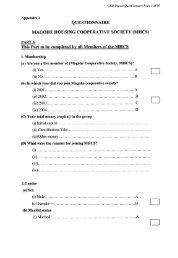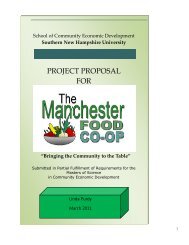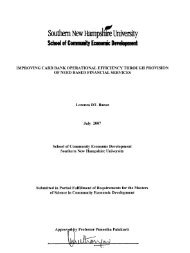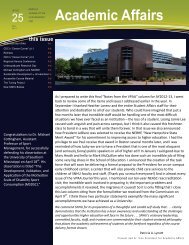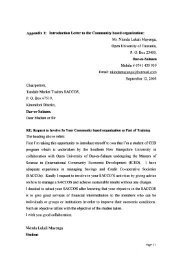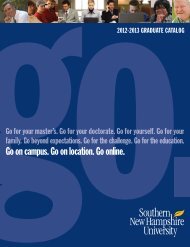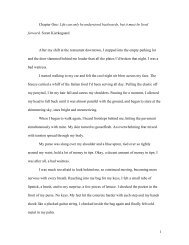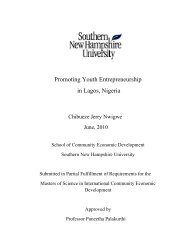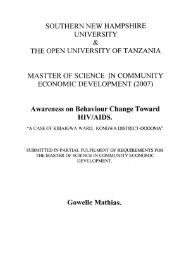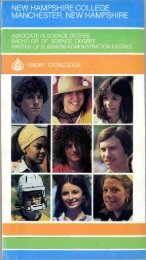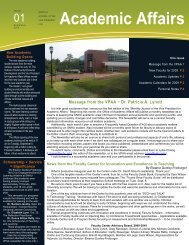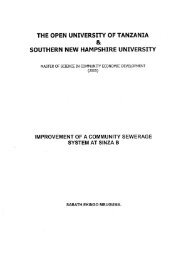Undergraduate Catalog 2010-2011 - SNHU Academic Archive ...
Undergraduate Catalog 2010-2011 - SNHU Academic Archive ...
Undergraduate Catalog 2010-2011 - SNHU Academic Archive ...
You also want an ePaper? Increase the reach of your titles
YUMPU automatically turns print PDFs into web optimized ePapers that Google loves.
Course Descriptions<br />
and pronunciation. Students will be expected to achieve<br />
approximately the novice-high level based on guidelines<br />
published by the American Council on the Teaching of<br />
Foreign Languages (ACTFL). Finally, awareness of the cultures,<br />
behaviors, and traditions of the Chinese-speaking<br />
world will also be emphasized. Class format will include a<br />
combination of lectures, demonstrations, tasks, and full class<br />
and small group discussions. Global Marker.<br />
LMN 112 Elementary Mandarin Language and Culture II<br />
(3 credits)<br />
A continuation of LMN 111. Global Marker.<br />
LSP 111 Beginning Spanish I (3 credits)<br />
Designed for students with no previous knowledge of Spanish;<br />
acquisition of first-semester, first-year proficiency in speaking,<br />
understanding, reading and writing Spanish with use of appropriate<br />
cultural and social contexts. Prerequisite: None.<br />
LSP 112 Beginning Spanish II (3 credits)<br />
Continuation of LSP 111. Prerequisite: LSP 111, by placement<br />
or permission of instructor.<br />
LSP 124 Culinary Spanish (3 credits)<br />
Students learn to converse in elementary Spanish spoken by<br />
Spanish-speaking co-workers in the culinary arts field.<br />
Course focuses on practicing speaking and vocabulary in<br />
conversational situations about menu items, culinary tools<br />
and techniques. Spanish and Latin American dishes, condiments<br />
and dining customs are presented as part of the cultural<br />
background. Prerequisite: None.<br />
LSP 211 Intermediate Spanish I (3 credits)<br />
Emphasis on oral communication and development of reading<br />
and writing skills. Samples of Hispanic literatures read and<br />
contemporary social issues discussed in Spanish. Prerequisite:<br />
LSP 112, by placement or permission of the instructor.<br />
LSP 212 Intermediate Spanish II (3 credits)<br />
Continuation of LSP 211. Prerequisite: LSP 211, by placement<br />
or permission of the instructor.<br />
LSP 311 Hispanic Cultures (3 credits)<br />
In this course students will explore the cultural, social, political,<br />
and artistic phenomena that have created the civilization<br />
and culture of the Spanish speaking people, the fourth<br />
largest cultural group in the world. Major influences in the<br />
development of Hispanic cultures are highlighted. An<br />
emphasis is given to contemporary culture. Conducted in<br />
Spanish; readings in Spanish and English. Prerequisites: LSP<br />
112 or permission of the instructor.<br />
Literature<br />
LIT 200 Introduction to Literature (3 credits)<br />
This course introduces students to the study and appreciation<br />
of literature. It explores the literary genres of short story,<br />
poetry, drama and novel. There is an option for nonfiction<br />
prose as well. The course covers an introduction to literary<br />
terminology and an introduction to critical analysis of literature.<br />
Prerequisite: ENG 120.<br />
LIT 201 World Lit I: Foundations of Culture (3 credits)<br />
This course explores both early European (classical and<br />
medieval) culture as well as the great non-European cultures<br />
of Asia, Africa, and the Americas up to the Renaissance.<br />
Readings will focus on major themes such as the hero, the<br />
role of women, ethical values, and views of nature, within<br />
the genres of Greek tragedy, comedy, epic and lyric poetry.<br />
Students will read authors such as Homer, Sophocles, Dante,<br />
Virgil, Cervantes, and Ovid. Although all texts are in English,<br />
this course is designed to give students competency in<br />
ancient and medieval literature outside the English tradition.<br />
Global Marker. Prerequisite: ENG 120.<br />
LIT 202 World Lit II: Renaissance to Modern (3 credits)<br />
This course introduces students to major works of world literature<br />
in translation, excluding the American and British traditions,<br />
from the late 1600s to the present. It includes African,<br />
Asian, European, Latin American and Middle Eastern literature,<br />
with an emphasis on the European. Students will read<br />
authors such as Pirandello, Chekhov, Tolstoy, Flaubert,<br />
Mahfouz, and Kafka. Prerequisite: ENG 120.<br />
LIT 203 Early American Literature (3 credits)<br />
This course begins before Columbus but focuses on the period<br />
from 1620—with the settlement of Plymouth Plantation—to<br />
the formation of American government in the late 18th century.<br />
Students will focus on literary texts of historical and cultural<br />
relevance and on authors who pursued the American<br />
Dream of economic, religious, political, and artistic freedom.<br />
Authors may include Bradford, Williams, Bradstreet,<br />
Rowlandson, Taylor, Mather, Franklin, Paine, Jefferson,<br />
DeCrevecouer, Equiano and Wheatley. Prerequisite: ENG 120.<br />
LIT 205 The American Renaissance (3 credits)<br />
This course examines literature from the early 1800s to 1865,<br />
the conclusion of the Civil War. During this period,<br />
American literature developed a home-grown Romanticism<br />
influenced by European intellectual and aesthetic movements,<br />
as well as a new cultural sensibility of its own.<br />
Authors may include Irving, Poe, Hawthorne, Emerson,<br />
Thoreau, Melville, Douglass, Dickinson, and the latter-day<br />
transcendentalism of Whitman. Prerequisite: ENG 120.<br />
LIT 207 American Realism and Naturalism (3 credits)<br />
This survey of American literature begins after the Civil War<br />
and ends early in the 20th century. The course will focus on<br />
the progression of American literature from Romanticism to<br />
Realism and Naturalism and towards Modernism. Students<br />
will read literature by authors who were responding to radical<br />
shifts in America after the Civil War, including Reconstruction,<br />
the rise of industrialism, and new theories of<br />
evolution. Authors may include Twain, James, Chesnutt,<br />
London, Dreiser, Wharton, Cather, and Anderson, as well as<br />
poets of the early twentieth century. Prerequisite: ENG 120.<br />
LIT 210 American Literature: 20th Century and Beyond<br />
(3 credits)<br />
This course will explore major novels, short stories, poetry,<br />
and plays from the modern period to the present, with<br />
emphasis on literature after WWI. Students will read texts<br />
that tackle the political, cultural, and literary issues dominat-<br />
149



